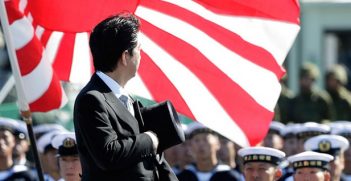Australia–Japan Security Cooperation

With the Minister for Foreign Affairs in Japan this week, there are some concerns that closer ties between Japan and Australia could undermine the stability of regional security. However, Japan and Australia have the potential to contribute to a liberal and inclusive order in the Asia-Pacific region.
Since the announcement of the Japan–Australia Joint Declaration on Security Cooperation in March 2007, security cooperation between Japan and Australia has developed rapidly. In April 2014, the leaders of both countries agreed to upgrade their security cooperation to a “special strategic partnership” and also signed the Agreement Concerning the Transfer of Defence Equipment and Technology.
Japan’s external security relationship building has, however, led some observers to conclude that Japan is pursuing an “external balancing” strategy against the rise of China by seeking to strengthen its relationship with regional powers such as Australia and India. There is a legitimate reason therefore for a country like Australia to worry about entanglement in ‘great-power’ rivalry in the region.
However, Japan and Australia have continued to maintain policy that values the rule-based international order, where disputes and issues are settled by peaceful means in accordance with international law. They also emphasise the importance of regional institutions like the East Asia Summit as an open, inclusive and transparent regional security mechanism. Indeed, it is through this ‘order-building’ effort that Japan and Australia have strengthened their relationship.
The crisis of an inclusive regional order
Due to the changing balance of power in the region, a stable, liberal and inclusive order as promoted by Japan and Australia faces several challenges.
China’s assertiveness in the South China Sea dispute has increased the division between claimants and non-claimants in ASEAN, thus making it play ‘an increasingly peripheral role in the management of these disputes’.
In responding to China’s challenge to the inclusive regional order, the USA has strengthened its military, economic and diplomatic commitments to its regional allies and partners under its rebalancing policy. Consequently, Japan and Australia have strong incentives to lessen the US burden in the Asia-Pacific by building further on their long-standing and highly successful bilateral relationship.
The evolving hedging strategy and its limits
Faced with these challenges, Japan and Australia have recently strengthened their bilateral and trilateral defence cooperation with the USA as a collective hedging strategy against the rise of China. The three countries, for instance, have regularly conducted bilateral and trilateral military training and exercises between air, maritime and ground forces.
At the same time, however, Japanese–Australian cooperation in hedging against a more revisionist China faces some important challenges: in particular, the so-called “China gap”, which is the rift between Japanese and Australian perceptions of what China represents in terms of opportunities and risks. Unlike Japan, where there is a broad consensus on the risks of the rise of China and its threats to Japanese territory and sovereignty, Australia holds much more divergent views on how to assess the rise of China.
Even domestically, polls show that Australians have increasingly warm feelings towards China, whereas Japanese attitudes towards China have continued to deteriorate and an increasing number of people are aware of its military threat.
China’s military build-up, with its ever-increasing military budget, has progressed at a much faster rate than that of Japan and Australia. This gap between the countries’ defence expenditure is likely to continue expanding. Even if Japan and Australia can supplement some of the USA’s activity in the region, they cannot meaningfully alter the strategic balance in the region.
While Canberra can pursue a close security relationship with Tokyo without sacrificing its relationship with Beijing, if the tension between Japan and China in the East China Sea increases in the future, there would be increased concern over Australia’s ‘entrapment’ in Sino-Japanese rivalry.
Beyond the China gap
Although Tokyo and Canberra undoubtedly have different threat perceptions of Beijing, they share broader interests in supporting a liberal, inclusive and rules-based international order. Most importantly, both countries see significant interests in maintaining the US military presence as the critical element to sustain such an order.
It is therefore critical for Tokyo and Canberra to enhance their defence and security cooperation in a way that enhances US military commitment. This can be done, for instance, through conducting timely and frequent joint military training and exercises involving the USA in various parts of the Indo-Pacific region. In addition to playing the role of junior allies of the USA, Japan and Australia can also make more autonomous contributions to the current rule-based order by strengthening their long-standing “middle-power cooperation”.
Such cooperation includes capacity-building and development, multilateral institution-building, norm-setting and coalition-building. This can indirectly influence the geo-strategic balance by reducing the burden on the USA while avoiding a direct confrontation with China.
Furthermore, it is becoming increasingly important for Japan and Australia to support ASEAN’s unity and centrality as a driving force for an open and inclusive regional security architecture. They could, for example, more frequently discuss how to strengthen ASEAN-led institutional mechanisms and how to spread norms like freedom of navigation within those frameworks.
Building a coalition of middle-power countries can better realise coordination among these countries by utilising resources more efficiently, and Japan and Australia can be drivers of the formation of such a coalition in the region.
With the emergence of great-power rivalry derived from a changing strategic landscape, maintaining an inclusive security order in the Asia-Pacific has become even more important, albeit difficult, not only for Japan and Australia, but for all regional actors. It is in this context that Japan and Australia have upgraded their security cooperation not only in the area of bilateral defence, but also in regional and global contexts.
Its fundamental aim is to maintain and enhance an inclusive order where regional countries, including Japan and Australia, can enjoy mutually beneficial relationships without having to ‘choose’ between two sides.
Dr Tomohiko Satake is a Fellow in the Defense Policy Division, Policy Studies Department, at the National Institute for Defense Studies in Tokyo. This piece is adapted from his article, “The Japan-Australia contribewrsdzkxpution to a liberal and inclusive regional order: beyond the ‘China gap’” published in the Australian Journal of International Affairs in February 2016.





